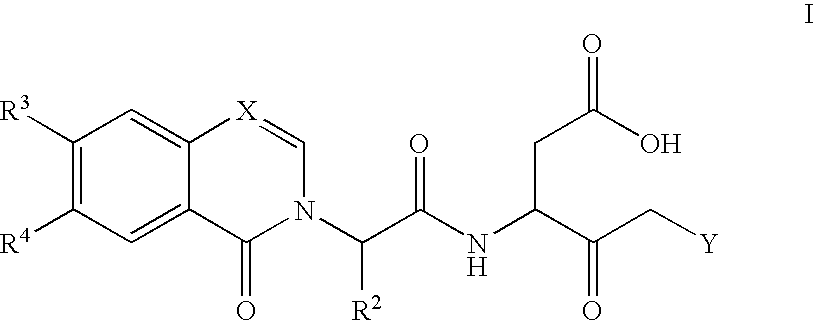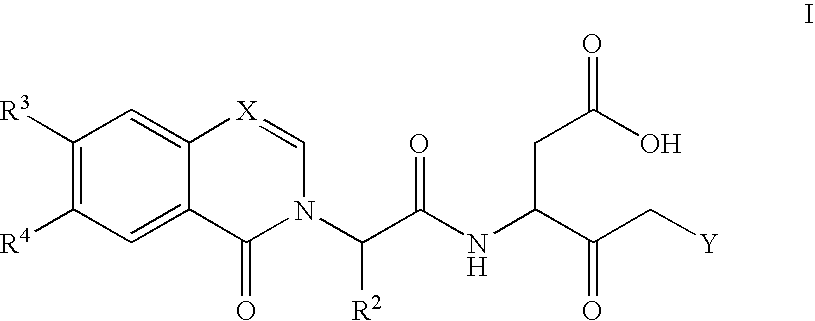Caspase inhibitors and uses thereof
a technology of caspase inhibitors and inhibitors, applied in the field of medicinal chemistry, can solve the problems of poor oral absorption, undesirable pharmacological properties of peptide inhibitors, and inability to reflect potency in cellular models
- Summary
- Abstract
- Description
- Claims
- Application Information
AI Technical Summary
Problems solved by technology
Method used
Image
Examples
example 1
(S)-3-[2-(7-chloro-1-oxo-1H-isoquinolin-2-yl)-butyrylamino]-5-fluoro-4-oxo-pentanoic acid
[0148]
Method A:
5-Chloro-2(2-methoxyvinyl)-benzoic acid
[0149]
[0150]To a cooled (0° C.) slurry of methoxymethyltriphenylphosphonium chloride (39 g) in a mixture of diethyl ether (200 ml) and tert-butanol (50 ml) was added potassium tert-butoxide (12.8 g) portion wise. The resulting mixture was stirred at 0° C. for 1 hour, then a solution of 2-formyl-5-chlorobenzoic acid (prepared as described in J. Org. Chem. 61, 3402 (1996)) (10 g) in diethyl ether (50 ml) was added dropwise over 15 minutes. The resulting mixture was stirred for 1 hour at 0° C., then warmed to ambient and stirred for an additional 90 minutes. The mixture was diluted with water (200 ml) and the organic phase removed. The aqueous phase was acidified to pH 1 with 1M HCl and extracted with ethyl acetate (3×50 ml). The combined extracts were washed with brine, dried (magnesium sulfate), filtered and concentrated. The residue was purif...
example 2
(S)-3-[2-(7-trifluoromethyl-1-oxo-1H-isoquinolin-2-yl)-butyrylamino]-5-fluoro-4-oxo-pentanoic acid
[0165]
[0166]This was prepared using procedures similar to those described in methods A-G (2-formyl-5-trifluoromethylbenzoic acid was prepared using a procedure similar to that described in J. Org. Chem. 61, 3402 (1996). The product was isolated as a white solid (93% last step). IR (solid)1782.6, 1746.8, 1644.4, 1629.0, 1603.4, 1321.8, 1275.7, 1168.1, 1127.2, 927.5 cm−1; 1H NMR (400 MHz, d6-DMSO) δ 0.82 (3H, m), 1.85-2.21 (2H, m), 2.35-3.21 (2H, m), 4.20-5.75 (4H, m), 6.80 (1H, m), 7.68 (1H, m), 7.92 (1H, m), 8.04 (1H, m), 8.49 (1H, s), 8.56-8.95 (1H, brm) ppm; 19F NMR (376 MHz, d6-DMSO) (proton decoupled) δ−61.32, −61.38, −226.70, −226.76, −230.47, −231.06, −232.61, −232.67; MS ES (−) 429.30 (M−H).
example 3
(S)-3-[2-(6-chloro-1-oxo-1H-isoquinolin-2-yl)-butyrylamino]-5-fluoro-4-oxo-pentanoic acid
[0167]
Method H:
4-Chloro-N-methyl-benzamide
[0168]
[0169]To a 0° C. solution of the 4-chlorobenzoyl chloride (4.50 g) in dichloromethane (10 mL) was added an 8M solution of methylamine in ethanol dropwise. The solution was stirred for 16 h and then evaporated to dryness. The residue was diluted with saturated sodium bicarbonate solution (10 mL) and extracted three times with ethyl acetate (3×20 mL), the organics washed with brine (10 mL), dried (MgSO4) and concentrated in vacuo to afford the sub-title compound as a white solid (4.33 g; 97%). 1H NMR (400 MHz, CDCl3) δ 3.00 (3H, s), 7.40 (1H, br) 7.40 (1H, d), 7.70 (1H, d) ppm.
Method I:
2-formyl-4-chloro-N-methylbenzamide
[0170]
[0171]To a solution of 4-chloro-N-methyl-benzamide (3.1 g) in THF (30 mL) was added n-butyl lithium (30.1 mL of 2.5M hexane solution) and the solution refluxed for 45 min. The solution was then cooled to 0° C. and N-methylforman...
PUM
 Login to View More
Login to View More Abstract
Description
Claims
Application Information
 Login to View More
Login to View More - R&D
- Intellectual Property
- Life Sciences
- Materials
- Tech Scout
- Unparalleled Data Quality
- Higher Quality Content
- 60% Fewer Hallucinations
Browse by: Latest US Patents, China's latest patents, Technical Efficacy Thesaurus, Application Domain, Technology Topic, Popular Technical Reports.
© 2025 PatSnap. All rights reserved.Legal|Privacy policy|Modern Slavery Act Transparency Statement|Sitemap|About US| Contact US: help@patsnap.com



